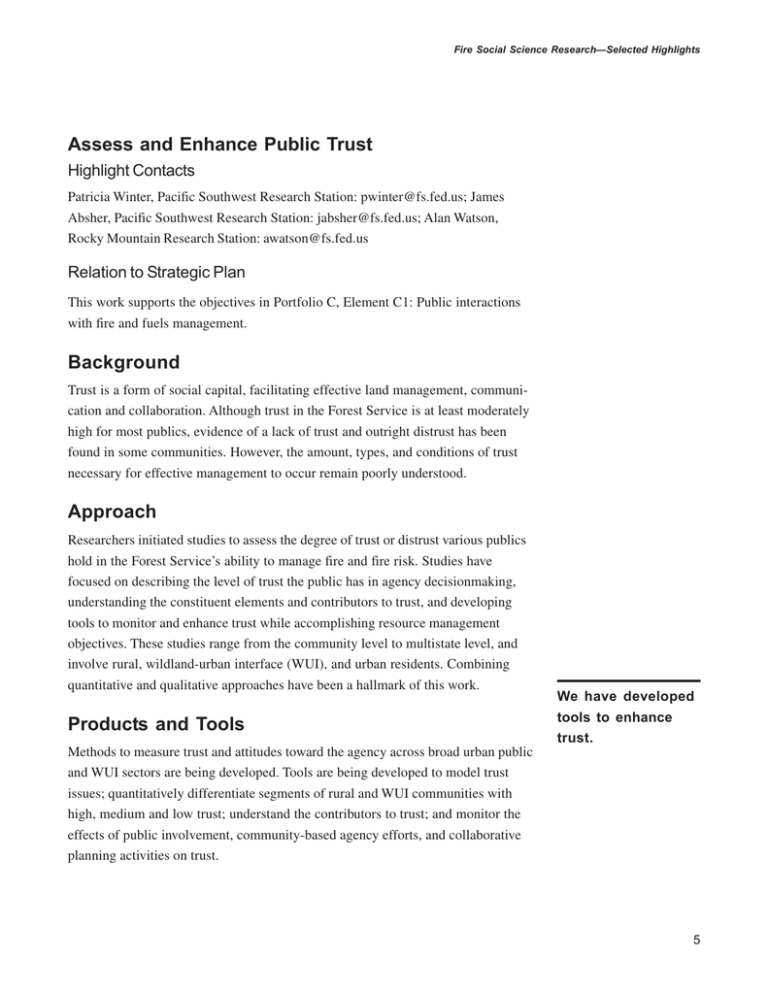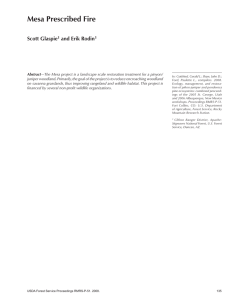Assess and Enhance Public Trust Highlight Contacts
advertisement

Fire Social Science Research—Selected Highlights Assess and Enhance Public Trust Highlight Contacts Patricia Winter, Pacific Southwest Research Station: pwinter@fs.fed.us; James Absher, Pacific Southwest Research Station: jabsher@fs.fed.us; Alan Watson, Rocky Mountain Research Station: awatson@fs.fed.us Relation to Strategic Plan This work supports the objectives in Portfolio C, Element C1: Public interactions with fire and fuels management. Background Trust is a form of social capital, facilitating effective land management, communication and collaboration. Although trust in the Forest Service is at least moderately high for most publics, evidence of a lack of trust and outright distrust has been found in some communities. However, the amount, types, and conditions of trust necessary for effective management to occur remain poorly understood. Approach Researchers initiated studies to assess the degree of trust or distrust various publics hold in the Forest Service’s ability to manage fire and fire risk. Studies have focused on describing the level of trust the public has in agency decisionmaking, understanding the constituent elements and contributors to trust, and developing tools to monitor and enhance trust while accomplishing resource management objectives. These studies range from the community level to multistate level, and involve rural, wildland-urban interface (WUI), and urban residents. Combining quantitative and qualitative approaches have been a hallmark of this work. Products and Tools We have developed tools to enhance trust. Methods to measure trust and attitudes toward the agency across broad urban public and WUI sectors are being developed. Tools are being developed to model trust issues; quantitatively differentiate segments of rural and WUI communities with high, medium and low trust; understand the contributors to trust; and monitor the effects of public involvement, community-based agency efforts, and collaborative planning activities on trust. 5 California Department of Forestry GENERAL TECHNICAL REPORT PNW-GTR-736 Effective fire management rests in part on trust between publics and managing agencies. Results and Applications Trust has been found to be centered in perceived values that are similar or dissimilar between agency and publics, as well as perceived consistency or inconsistency of action with those values and validity of reasons underlying inconsistencies (Cvetkovich and Winter 2007). It has been shown to mediate and reinforce the relationship between values and public support for wildland fire management actions such as thinning and prescribed burning (Liljeblad and Borrie 2006; Liljeblad et al., in press; Vaske et al. 2007). However, more work is needed to understand the role trust plays in natural resource decisions, and how trust is lost and gained. Some of the basic tenets of trustworthiness (credibility, honesty, similarity) may or may not be the best foci of agency members seeking to build trust. The importance of trust has been demonstrated concerning reliance on, and likelihood of taking action on, information provided by National Predictive Services. Findings from this will be used to make strategic decisions about communication with various segments of the fire management community in the federal and nonfederal sectors. The Bitterroot Ecosystem Management Project has assessed trust across communities to understand baseline levels of trust, engaged the public in geographic 6 Fire Social Science Research—Selected Highlights information system-based values mapping activities to understand the relationship between the public and the Bitterroot National Forest, and will perform postdecision and postimplementation trust monitoring measurements. On the Lewis and Clark National Forest, scientists provided an analysis of the relationship between trust and the principles of high-reliability organizing during public collaboration on a plan for prescribed fire. In Colorado and southern California, results have helped local agencies understand trust issues for WUI residents and assisted community-based fire preparedness communications (e.g., FireWise and Fire Safe Council work, Absher et al. 2006, Cvetkovich and Winter 2007). Principal Investigators James Absher, jabsher@fs.fed.us: Pacific Southwest Research Station; Sarah McCaffrey, smcaffrey@fs.fed.us: Northern Research Station; Alan Watson, awatson@fs.fed.us: Rocky Mountain Research Station; Patricia Winter, pwinter@fs.fed.us: Pacific Southwest Research Station Key Partners Colorado State University, Confederated Salish and Kootenai Tribes of Montana, Forest Service Northern Region: Bitterroot National Forest and Lewis and Clark National Forest, Fort Lewis College, Michigan State University, National Predictive Services, University of Florida, University of Minnesota, University of Montana, Western Washington University Funding This research was supported by the National Fire Plan, Joint Fire Science Program, National Predictive Services Group, and the Bitterroot Ecosystem Management Research Project. Literature Cited Absher, J.D.; Vaske, J.J.; Bright, A.D.; Don Carlos, A. 2006. Effective communication about wildfire management along the Colorado Front Range. In: Decker, D.; Lardner, M., comps. Proceedings of the third international fire ecology and management congress. Pullman, WA: Washington State University. [DVD, track 2, community wildfire management]. www.emmps.wsu.edu/ 2006firecongressproceedings. (May 29, 2007). 7 GENERAL TECHNICAL REPORT PNW-GTR-736 Cvetkovich, G.T.; Winter, P.L. 2007. The what, how, and when of social reliance and cooperative risk management. In: Siegrist, M.; Earle, T.C.; Gutscher, H., eds. Trust in cooperative risk management: uncertainty and skepticism in the public mind. London: Earthscan: 187–209. Liljeblad, A.; Borrie, W.T. 2006. Trust in wildland fire and fuel management decisions. International Journal of Wilderness. 12(1): 39–43. Liljeblad, A.; Watson, A.E.; Borrie, W.T. [In press]. A look inside the dynamics of trust: a guide for managers. In: Watson, A.; Sproull, J.; Dean, L., comps. th Science and stewardship to protect and sustain wilderness values: 8 world wilderness congress symposium; 2005. Proceedings. Fort Collins, CO: U.S. Department of Agriculture, Forest Service, Rocky Mountain Research Station. Vaske, J.J.; Absher, J.D.; Bright, A.D. 2007. Salient value similarity, social trust and attitudes toward wildland fire management strategies. Human Ecology Review. 14(2): 217–226. Additional Readings Cvetkovich, G.T.; Winter, P.L. 2004. Seeing eye-to-eye on natural resource management: trust, value similarity, and action consistency/justification. In: th Tierney, P.T.; Chavez, D.J., tech. coords. Proceedings of the 4 social aspects and recreation research symposium. San Francisco: San Francisco State University: 46–50. Knotek, K. 2005. Human aspects of fire and fuels management in the Northern Rockies. Eco-Report (Fall 2005). Missoula, MT: U.S. Department of Agriculture, Forest Service, Rocky Mountain Research Station, Bitterroot Ecosystem Management Research Project, Leopold Institute. 573: 9. Liljeblad, A. 2005. Towards a comprehensive definition of trust: understanding the public’s trust in natural resource management. Missoula, MT: The University of Montana. 112 p. M.S. thesis. Winter, G.; Vogt, C.; McCaffrey, S. 2004. Examining social trust in fuels management strategies. Journal of Forestry. 120(6): 8–15. 8 Fire Social Science Research—Selected Highlights Winter, P.L. 2003. Californians’ opinions on wildland and wilderness fire management. In: Jakes, P.J., comp. Homeowners, communities, and wildfire: science th findings from the National Fire Plan. Proceedings of the 9 international symposium on society and resource management. Gen. Tech. Rep. NC-231. St. Paul, MN: U.S. Department of Agriculture, Forest Service, North Central Research Station: 84–92. Winter, P.L. 2006. Urban proximate wilderness visitors’ preferences for fire manrd agement. In: Decker, D.; Lardner, M., comps. Proceedings of the 3 international fire ecology and management congress. Pullman, WA: Washington State University. www.emmps.wsu.edu/2006firecongressproceedings/Changes/ PatWinter.pdf. (May 29, 2007). Winter, P.L.; Bigler-Cole, H. 2006. Improving a national fire information prord gram: a needs assessment approach. Proceedings of the 3 international fire ecology and management congress. [DVD, track 2, public perception]. www.emmps.wsu.edu/2006firecongressproceedings. (May 9, 2007). Winter, P.L.; Bigler-Cole, H. [In press]. Information needs, tolerance for risk, and protection from risk: the case of national predictive services customers. In: Beatty, J.J.; Lee, D.C.; Pye, J.M.; Sands, Y., eds. Proceedings on advances in threat assessment and their application to forest and rangeland management conference. Gen. Tech. Rep. Asheville, NC: U.S. Department of Agriculture, Forest Service, Southern Research Station. http://forestencyclopedia.net. (May 9, 2007). Winter, P.L.; Cvetkovich, G.T. [In press a]. Diversity in southwesterners’ views of Forest Service fire management. In: Martin, W.E.; Raish, C.; Kent, B., eds. Wildfire and fuels management: risk and human reaction. Washington, DC: Resources for the Future. Winter, P.L.; Cvetkovich, G.T. [In press b]. Perceptions, impacts, actions, shared values, and trust: the experience of community residents in a fireprone ecosystem. In: Beatty, J.J.; Lee, D.C.; Pye, J.M.; Sands, Y., eds. Proceedings on advances in threat assessment and their application to forest and rangeland management conference. Gen. Tech. Rep. Asheville, NC: U.S. Department of Agriculture, Forest Service, Southern Research Station. http://forestencyclopedia.net. (May 9, 2007). 9

